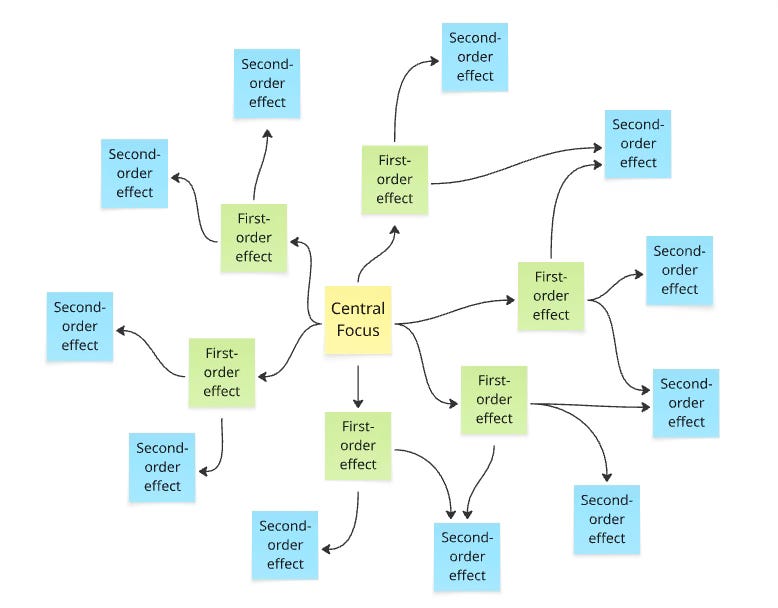Good CEOs See the Distant Future. Great Ones Master the Near Term
Two ideas and one simple tool for razor-sharp future thinking
CEOs burn tons of energy trying to predict the future — when what really matters is often right under their noses.
After studying how top business leaders approach future thinking, exploring strategic foresight, and applying those ideas in dozens of strategy projects, I've developed a simple formula.
It’s not rocket science — but it’s practical, clear, and it actually helps.
When bold predictions meet harsh reality
In its 2016 report, Gartner predicted that:
1. By 2020, 100 million consumers will shop in augmented reality
2. By 2020, 30% of web browsing sessions will be done without a screen
3. By 2022, a blockchain-based business will be worth $10 billion
4. By 2020, 40% of employees can cut their healthcare costs by wearing a fitness tracker
As you can see, only prediction #3 came true. In other predictions, Gartner was about as accurate as I am when playing darts with my nephews.
As Christopher Mims, a tech columnist for The Wall Street Journal, once noted, “disruption is overrated.”
A short list of innovations that talked the talk — but didn’t walk the walk:
· AR Glasses
· 3D printing
· Metaverse
Disruption is overrated—and so is our ability to predict the future. We can’t tell if it’ll rain tomorrow— how can we trust anyone who claims to know what gadgets we'll be carrying five years from now?
We can’t predict the future — but we can think into the future, focusing on trends that are already visible, just like many successful entrepreneurs have done.
Some leaders try to “calculate” the future with analytics and scenario planning. Others boldly trust their gut. Some tune their radar to “weak signals,” hoping to catch what others miss.
The successful ones? They just bet on obvious, boring trends — the kind that quietly shape the next few decades.
Steve Jobs, new campus and 2011 strategy
On October 24, 2010, Steve Jobs sent an email with the agenda for Apple’s upcoming top-secret offsite management meeting.
The agenda was:
“2011 strategy – SJ
Who are we?
What do we do?
Post PC era
2011: Holy War with Google
2011: Year of the Cloud
2015: New Campus”
A one-year strategy? Seriously?
No BHAGs, bold 10-year visions, or big dreams!
So, Apple's boldest long-term move in 2010 was... building a campus? But in fact, there was a deeper meaning behind it.
Steve Jobs never made bold predictions for the distant future because:
1. He was too busy building the future
2. He focused on an apparent trend—the post-PC era
Steve Jobs deeply believed in the human ability to change the world. But the idea of "the cloud" was neither his nor new.
For instance, Google introduced the Chromebook — a computer where almost everything ran through the browser — back in 2009. Not that Jobs ever cared about details like that.
However, Jobs understood that this trend was both far-reaching and long-lasting, which is why the word era wasn’t used lightly.
Jobs wanted Apple to capitalize on it — and it did: in 2011, Apple introduced iCloud.
Here are the two ideas:
1. Stop trying to guess the future; you'll get it wrong anyway. Start building it by creating groundbreaking products
2. Focus on long-term trends, not short-lived fads.
Master near-term strategy by (1) betting on obvious trends, (2) building rather than predicting, and (3) working backwards from customer needs.
This approach forms the backbone of my strategy work. Here's the step-by-step process:
Future thinking formula
Step 1
When I help businesses with strategy, I always start with a foresight game. We try to build a vivid, plausible picture of the world ten years from now.
Note — we're not trying to predict or guess the future. I don’t have a crystal ball — and I don’t believe in astrology either. We know we’ll probably be wrong anyway. But that's not the point. We do it for other reasons:
We imagine the kind of future we’d like to build — not just what might happen. That shift puts the team in a proactive mindset.
The foresight game is a powerful mental warm-up. It helps people start thinking into the future.
It sparks insights you can use right away.
And it helps us spot the long-term trends that won’t be gone tomorrow.
Step 2
Once we’ve sketched out the distant future, we don’t stay there for long. We keep it in mind but shift our focus back to the next two to four years — and dig deeper into the trends we've already identified.
Steps 3 and 4
Trends don’t just appear out of nowhere. They emerge when someone spots an unmet need — and finds a new way to meet it.
For example:
· Human laziness turned out to be a powerful driver — it helped fuel the boom in subscriptions.
· Teenagers’ belief that it’s better to look weird than look like everyone else gave fast fashion its moment.
· The quiet rebellion against "office life as identity" sparked the rise of casual wear and mindfulness.
In steps 3 and 4, we go deeper into the customer needs behind these trends — and look for new ways to meet them. When we do, we have a bedrock for the future strategy. At its core, strategy is about three things: whose needs you’ll meet, what they are, and how you’ll do it.
You can see this formula in the picture below:
Here are a few quick examples:
Shopify saw that small businesses were rushing online — and gave them the tools to launch their own stores without touching a line of code.
Revolut noticed how tired people were of traditional banking and built a digital-first alternative that felt more like an app than a bank.
DoorDash understood that convenience was king — and focused on smooth delivery in smaller cities, where big players were barely present.
I use many tools in strategic foresight workshops, but one stands out — it takes zero preparation, and you could try it tomorrow.
My book is now available as a podcast. Learn more here.
Futures Wheel
The Futures Wheel is a brainstorming tool for exploring the potential consequences of an event, trend, or decision. Jerome C. Glenn introduced the Futures Wheel in 1971.
Pick a meaningful change—either already unfolding or just emerging (central focus). It could be a new trend or a shift in your industry or the world that may have a major future impact.
With your team, use sticky notes to outline possible first-order effects. Then, explore second-order effects as well.
Example:
Central focus – the rise of industrial robots.
One of the first-order effects – robots replacing manual workers.
One of the second-order effects – fewer schools training such workers.
The Futures Wheel helps you view the possible future from multiple dimensions and various angles. But if you believe you need a full-scale foresight game to map the future of your market, you can learn more about foresight games here.
Conclusion
Get your team together and build a few Futures Wheels around the trends you’re seeing right now. What do they make you think about? How could you act on them today?
Now, sketch out what your industry might look like in 2035. What parts of that future would
you love to speed up? And what could you do today to make that happen? Start there—the future isn't something that happens to you, it's something you build, one obvious trend at a time.
Want to dive deeper? I run strategy workshops using these exact tools.
This is the third article in a series of eight that explores the habits that distinguish deep strategic thinkers. Read the previous ones here and here.
A present for you
A year ago, I published my book Red and Yellow Strategies: Flip Your Strategic Thinking and Overcome Short-termism. To celebrate the anniversary, I’m offering a special price — all through June.
🎧 Get the audiobook at a special price here.
📘 Get the ebook at a special price here.
⭐️ Upgrade to a paid subscription and get the book for free — plus full access to the archive, all podcast episodes of the book, and every members-only post on Substack.
And of course, you can still grab the book at full price in your favorite bookstore.
––
Read also: Blue Ocean Fallacy
Visit my website.








How is this different from Russell Ackoff's Idealized Design?
Or is it practically the same?
Such a nice way to think about strategy, cheers